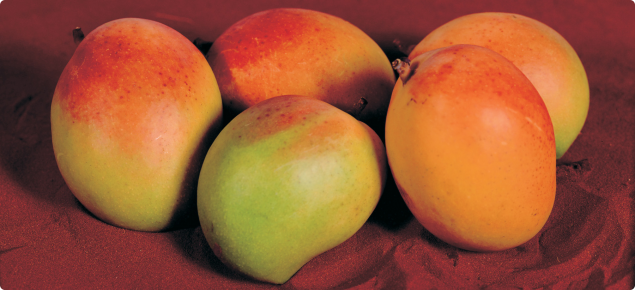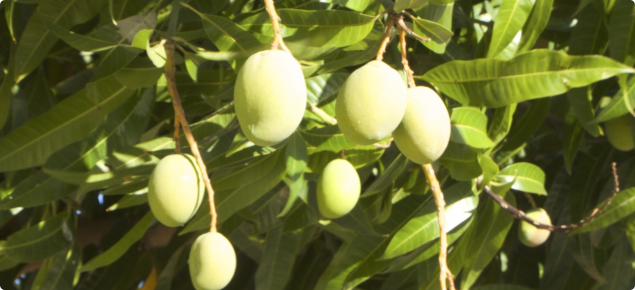Varieties
Early or mid-season mango varieties are the most suitable for the Perth area. Fruit from these varieties will ripen in March and April. This means the tree will flush before winter, flower in early spring and produce its crop in late summer.
Late varieties such as Keitt are not suitable because they ripen too late and will not flush before winter. This results in biennial bearing, which means good cropping one year, followed by poor cropping in the next season.
The main commercial variety around Perth is Kensington Pride, commonly known as “KP”. It produces red-blushed fruit weighing 300-500g. It may be grown from seedlings or grafted on rootstock, which is more expensive.
| Variety | Timing | Characteristics |
|---|---|---|
| Haden | 1-2 weeks later than KP | Small to medium fruit Red blush Different taste to KP |
| Namdok Mai | Same time as KP | Long yellow, elongated fruit Sweet nutty flavour Common variety in Thailand |
| R2E2 | 1-2 weeks later than KP | Second most common variety in Perth area Large fruit Good shape Good storage Moderate taste |
| Kent | 2-3 weeks later than KP | Large fruit with red blush Good flavour Low fibre Biennial bearing and poor quality fruit may be a problem in cooler areas |
Nursery management
KP is polyembryonic, which means that several embryos develop within a single seed. Each embryo will produce trees that are true-to-type. The best time for planting seeds is in summer, as this will enable good growth before winter. It is best to obtain seeds from trees which have good yields and quality. See link on propagating mangoes for information on growing from seed.
Keep the plants in a sheltered position in a nursery for at least the first two winters and protect them from frost. Plants will grow well given a slow release, well balanced fertiliser. Pot-on to 20cm and 30cm diameter pots as the plants grow. They can be kept in pots until they are more than 1 metre high.
Mango varieties other than KP should only be purchased as grafted plants to ensure that they are true-to-type.
Field management
Choose a well-drained site and plant out in rows that face north. The ideal time to plant out is early October, or in frost-prone areas, early November.
For the first two years, young plants should be protected with 50% density shade cloth above and around the plants. It is preferable to have this installed before planting. This will moderate temperatures and protect against wind, frost and kangaroos.
Mangoes require little pruning, but the main shoot should be cut in spring at about 1 metre high to produce a framework of three to four main branches. Young mango trees can be killed by slight frosts. Established trees will survive mild frosts, but suffer some damage.
Incorporate compost into the hole before planting. Water immediately after planting. Mulch plants with compost and/or organic material and apply organic manure lightly and occasionally for at least the first three years.
Wind protection is essential to ensure good growth and minimise the spread of disease. Permanent windbreaks of river she-oak (Casuarina cunninghamiana) will protect plants from wind, but sucker re-growth must be removed every year. Temporary windbreaks of sorghum can also be used to protect plants.
Typical tree spacings in the Perth area are:
- 6-8m X 2.0-3.5m
- 7.0m X 3.0m
- 6.5m X 3.25m.
Trees bear fruit on the terminal shoots of branches which receive good light. Production will decrease if branches are shaded due to intermingling with adjacent trees. With closely-spaced trees, it is necessary to remove alternate trees in the rows after about 15 years.
Less frost damage will be expected if plantings are on high north-facing slopes. Young trees should be sprinkled with water when the temperature falls below 3°C to minimise frost damage.
Trees are slow growing, with only one to three flushes of growth per year. Growth may also be slow when they begin fruiting.
Trees should be lightly pruned to allow mottled light to pass through the canopy to promote good fruit colour. However, if trees are pruned too severely exposed stems can be sunburnt and up to 30% fruit lost from sunburn. Exposed stems of young and old trees may need spraying with a white water-based paint for sun protection.
Fertilising and irrigation
Mango trees only need moderate quantities of fertiliser. For the first four years, apply a good, mixed fertiliser each month from August to April. A well balanced commercial fertiliser contains about 15% nitrogen (N), 2.2% phosphorus (P), 16.6% potassium (K), 1.2% magnesium (Mg), 8% sulphur (S) and trace elements.
| Year | 1 | 2 | 3 | 4 |
|---|---|---|---|---|
| Amount | 750g | 1kg | 1.5kg | 2kg |
Extra applications of zinc sulphate at 2g/L may need to be sprayed onto small trees grown on alkaline sandy soils. Do not apply too much nitrogen to fruiting trees as this will result in excessive vegetative growth and poor fruit quality.
Commence the following fertiliser regime for a Year 5 tree and increase annually to the program for established trees (10-15 years).
| Timing | Fertiliser | Amount per tree Year 5 (kg) | Amount per tree Years 10-15 (kg) |
|---|---|---|---|
| Mid-August | NPK | 0.50 | 1.5 |
| Mid-October | NPK | 0.75 | 2.0 |
| Late November | NPK | 0.75 | 2.0 |
| Early January | Potassium nitrate | 0.50 | 1.5 |
| Early February | Potassium nitrate | 0.50 | 1.5 |
| April (after harvest) | NPK | 0.30 | 1.0 |
Commercially available leaf analyses will indicate whether the leaves have optimal nutrient status. See Managing an established mango orchard for more information.
Mature trees with low level sprinklers need about 11 000kL of water per hectare per year, especially from September to April. Established trees should be watered every two to three days in summer. Young trees may need daily watering. Also apply water in cooler months from April to September during dry periods.
The level of total soluble salts in the irrigation water should be less than 1000ppm and preferably less than 500ppm. If the level of salts is too high it will affect fruit yield and quality and the margins of the leaves will be scorched.
Pests and diseases
Anthracnose fungus disease (Colletotrichum sp.) is more severe around Perth than in northern growing areas. It may cause brown spotting of the leaves, flowers and fruits, which requires fungicide sprays of mancozeb or zineb every month from flowering to harvest. These sprays will also help control zinc deficiency.
Wingless grasshoppers can damage young trees in summer.
Mediterranean fruit fly occasionally damages fruit and a baiting program may be needed in some districts.
Fruiting
One metre high trees between three and four years old will produce their first fruits in early autumn, if irrigated regularly. It is beneficial to remove these fruits at an early stage, to promote good tree growth and increase future production. The time to the first good crop may be seven years.
Mangoes flower profusely in September and October on the terminals of shoots, but only a small proportion of flowers will produce marketable fruit. Poor flowering and fruit set in spring can be due to low temperatures.
KP is harvested from mid-March to the end of April in the Gingin area. Mature trees under good management bear six trays (42kg) per tree. Yields will be less per tree and fruit will be smaller at high planting densities.



